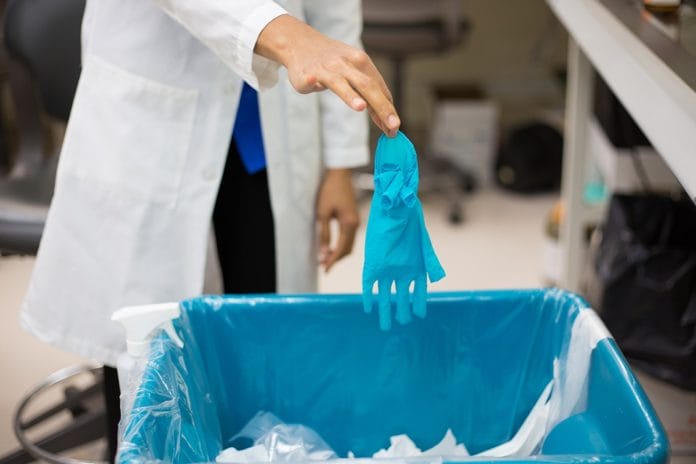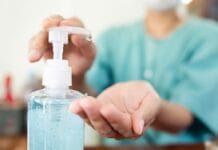Recently, I had the honor of listening to Dr. John A. Molinari, Ph.D. speak on “Health, Safety, Protection & Infection Control in the Dental Practice: Current Status 2019.” I was interested in attending his seminar to assure my office and I am up-to-date on the latest infection control recommendations. Needless to say, I was expecting a long, semi-boring, but informative, day of instruction. To my surprise, Dr. John Molinari put on one heck of an interesting seminar on infection control. I will encourage you to go to any seminar in which he speaks.
An interesting fact I learned from Dr. John Molinari was that germophobic, fearful hospitals collected cell phones from visitors at the front desk, tested them for bacteria, and discovered that there was more MRSA on visitors’ cell phones than the hospital workers’ cell phones. It was discovered hospital workers and medical/dental professionals are actually doing a great job at preventing cross-contamination of germs. It’s the outliers, who occasionally give the medical and dental professionals a bad name, who are the rotten-apples the news media gets hold of and barrages the public with. As healthcare professionals, we are all suspect to the public. Good and obvious infection control practices are not just put in place to protect us, but for patients to see what a good job we are doing protecting them.
Dental Unit Water Lines
In 2015, bad dental unit waterlines were to blame for an outburst of Legionnaires’ Disease in NYC & Flint, Michigan. Out of 187 total cases, twenty people died. This is unacceptable. Legionnaires’ Disease is a severe form of pneumonia caused by legionella bacterium which usually affects the elderly, immunocompromised, or the very young. Today, most dental units are supplied with self-contained water lines to prevent disease and public worry. Running your air-water syringe in the morning for two minutes each day flushes out stagnant water and helps prevent the risk of waterline contamination. Don’t forget to shock your lines every 2-3 months.
Hand Hygiene
Hand hygiene is another point of common sense infection control. Non-antimicrobial soap is fine to use and is actually preferred over constant use of antimicrobial soap, which increases permeability of epithelium and can cause dermatitis.1,2 With dermatitis there is obviously a higher risk of contamination. Emerging hand hygiene issues of increased tolerance to bacterial pathogens (E. faecium) to antimicrobial hand soap, make alcohol antiseptics a general consideration.2 When hand washing is done correctly, it takes care of 98% of bacterial transient flora…if done correctly!1,2 The good news is hand sanitizers are actually preferred over hand washing (if hands are not visibly soiled). Wearing gloves in the dental practice obviously eliminates the “soiling” of the hands, so hand sanitizers are a top choice for hand hygiene. Hand sanitizers are easy to use, they work rapidly, and if dispensed and used where the patient can visibly see, creates an atmosphere of mutual protection.
As mentioned above, non-antimicrobial soap works only when used properly. Wet your hands first with warm or cold water (tepid is perfect), lather with soap thoroughly by rubbing hands together, washing back of hands, between fingers, and under nails for 30-60 seconds (ideally 60 seconds), rinse thoroughly in tepid water. This first wash sets the stage for subsequent 15-20 second washings. Dry gently and thoroughly. If using hand sanitizer, apply hand sanitizer and rub as above for twenty seconds, do not rinse, air dry.
The most challenging part of hand hygiene for hygienists is the recommended removal of rings. Rings harbor extra bacteria in their nooks and crannies, and dermatitis may occur on the skin under the band from improper rinsing and drying. Think of having ringworm or athlete’s foot on your hand! There is no such thing as a germ-free life, but we can be reasonable with our hand-hygiene considerations without becoming germaphobic.
Lotion considerations: Avoid petroleum-based lotions as they react with gloves and compromise their integrity. Use instead, water-based lotions with dimethicone as an ingredient that aids in tissue repair.
Sharps Injuries
When treating patients with HBV, HCV, or HIV, the potential transmission risk to healthcare workers from a needlestick is highest for HBV. HBV transmission rate post-needlestick is 6.0-30.0%, HCV transmission rate is 2.7-6%, whereas HIV potential transmission rate post-needlestick is only 0.3%.2,3 The number one problem of occupationally-acquired HIV infection is recapping needles. Use the scoop technique or a needle recapper. Also, there is no need to change sterilization protocols when treating HIV patients; continue to use standard precautions.
Cassettes are a great way to reduce accidental sharps injuries. If your office does not have the sterilization capacity for cassettes, then use tray covers when transferring to the sterilization area. Be consistent to minimize accidents. Hand scrubbing instruments is not as efficient as ultrasonic cleaners, and it is dangerous. If you must hand scrub instruments, wear puncture-resistant, heavy, utility gloves.
Protect Yourself Appropriately
Protect your eyes. They are the least protected part of your body and are an open target for aerosols and splatter. Protect your face. An ASTM level 3 mask is your best protection against occupational respiratory infections.2,4 Protect your hands. Chloroprene gloves are more flexible, as well as right-left fitted gloves to avoid hand fatigue.2,5
Sterilization
When it comes to actual sterilization procedures, the most important thing to avoid is overloading the sterilizer which may lead to cycle failure. Avoid the temptation before lunch and at the end of the day to cram the sterilizer with every bag of instruments that are ready to go. Advise co-workers of the risk of cycle failure. Place class V strips in the center of the load to monitor and log sterilization efficacy. Check sterilization bags for punctures and re-bag if necessary.
Think of infection control as a big chain where all of the links are important to the whole. Every step in infection control reinforces the next step; whereas every weak link ruins the next step. Treat every patient as if they are infected and the links will remain reinforced! This is why the entire staff needs to be on the same page with infection control – to keep the chain of infection control reinforced.
To read the full Guidelines for Infection Control in Dental Health Care Settings, click here.
Before you leave, check out the Today’s RDH self-study CE courses. All courses are peer-reviewed and non-sponsored to focus solely on high-quality education. Click here now.
Listen to the Today’s RDH Dental Hygiene Podcast Below:
DON’T MISS: 5 Infection Control Mistakes You Might Not Realize You’re Making
References
- CDC. Guidelines for infection control in dental health-care settings. MMWR 2003; 52(RR- 17):1-66. www.cdc.gov/mmwr/PDF/rr/rr5217.pdf
- Boyce. Critical importance of hand hygiene. Am JIC (2013); JAM. DE (2016). http://www.nodc.org/images/stories/2018/Handouts/Infectrion-Control.pdf
- Lanphear B, Linnemann C, Cannon C. et al. Hepatitis C virus infection in healthcare workers: risk of exposure and infection. Infection Control Hosp Epideminol. 1994: 15:745-750. Epid Rev (1994); CDC 2011. https://www.jvir.org/article/S1051-0443(13)01510-8/pdf
- Molinari J, Nelson P. Face masks: What to wear and when. Translating the Science. The Dental Advisor. Number 18. October 2014. https://www.dentaladvisor.com/pdf-download/?pdf_url=wp-content/uploads/2015/02/face-masks-what-to-wear-and-when.pdf
- Molinari J. Let’s talk about infection control. The Dental Advisor. February 2015. http://www.nlda.net/Monlinari%20-%20Infection%20Control.pdf
*Credit needs to be given to Dr. John Molinari, Ph.D. who has published over 500 scientific articles and abstracts in the areas of microbiology and immunology. He lectures internationally on infection control and infectious diseases. His immense knowledge on the topics of microbiology and infection control have earned him great esteem amongst his peers and the dental world in general. Verbal permission was granted by Dr. Molinari to use information gained at his seminar for the writing of this article.












